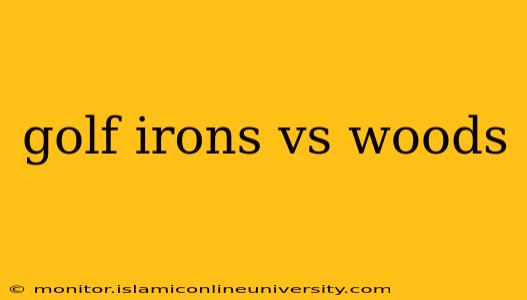Choosing the right golf club can significantly impact your game. Understanding the differences between irons and woods is crucial for any golfer, whether you're a seasoned pro or just starting out. This guide breaks down the key distinctions between these two fundamental club types, helping you select the perfect tool for each shot.
What are Golf Irons?
Golf irons are characterized by their relatively short clubheads with a compact, typically bladed, design. They are designed for precision and control, particularly crucial for shots requiring accuracy around the green. The number stamped on the iron indicates its loft (the angle of the clubface), with lower numbers representing lower loft (less angle) and greater distance potential, and higher numbers representing higher loft (more angle) for shorter, higher shots.
Types of Irons:
- Long Irons (2-4 irons): These offer the longest distance potential but require a strong swing and precise contact.
- Mid Irons (5-7 irons): Versatile clubs suitable for a range of shots from the fairway and rough.
- Short Irons (8-PW): Used for shorter shots, approach shots, and shots around the green.
- Pitching Wedge (PW): Offers a higher trajectory and more spin for shorter approach shots.
- Sand Wedge (SW) and others: Specialized wedges designed for specific shot types.
What are Golf Woods?
Golf woods, in contrast, feature larger clubheads with a more rounded design. This larger sweet spot makes them more forgiving on off-center hits, leading to more consistent distance. They are typically used for longer shots from the tee box or fairway, prioritizing distance over pinpoint accuracy. The numbers on woods (like a 3 wood, 5 wood, etc.) again indicate loft, but with lower numbers representing less loft and greater distance potential.
Types of Woods:
- Driver (1 wood): The club used for the longest shots off the tee.
- Fairway Woods (3-7 wood): Used for long shots from the fairway or tee box. The number indicates loft, with lower numbers having less loft and greater distance.
- Hybrids: Clubs that combine the characteristics of irons and woods, offering a blend of distance and accuracy. They often replace long irons in modern golf sets.
Irons vs. Woods: A Direct Comparison
| Feature | Irons | Woods |
|---|---|---|
| Clubhead Size | Smaller, more compact | Larger, more oversized |
| Loft | Lower loft (less angle) for longer shots, higher loft for shorter shots | Lower loft (less angle) for longer shots, higher loft for shorter shots |
| Distance | Shorter distances | Longer distances |
| Accuracy | Higher accuracy | Lower accuracy (but more forgiving) |
| Forgiveness | Less forgiving | More forgiving |
| Typical Use | Approach shots, shorter shots, around the green | Tee shots, long shots from the fairway |
What are the best golf clubs for beginners?
Beginners often find it beneficial to start with a set of clubs that prioritize forgiveness. A set including a driver, a few fairway woods (like a 3 wood and 5 wood), and a set of forgiving irons (often with larger clubheads and cavity backs) will provide a good balance of distance and accuracy. Hybrid clubs can also be highly beneficial for beginners as they replace long irons and offer increased forgiveness. Consider taking lessons from a PGA professional to determine the best clubs for your swing and game.
What are the differences between woods and irons in terms of swing?
The swing for woods is typically longer and more sweeping, aiming for a smoother, more fluid motion to generate power. The swing for irons tends to be more compact and controlled, with a steeper downswing to emphasize accuracy. The grip pressure also differs; a lighter grip is preferred for woods, allowing for a smoother swing, while a slightly firmer grip is used for irons to improve control.
Which clubs are better for different types of shots?
Irons excel in situations requiring precision and control, such as approach shots, shots around the green, and shots from tight lies. Woods are ideal for maximizing distance from the tee box or fairway, and in situations where some loss of accuracy is acceptable in exchange for a longer shot. Hybrids offer a valuable compromise, bridging the gap between the distance of woods and the accuracy of irons.
What is a hybrid club?
A hybrid club combines the characteristics of both irons and woods. They typically feature a larger clubhead like a wood, providing more forgiveness, yet also have a lower profile and a higher launch angle compared to typical woods, making them suitable for various shots. They are frequently chosen by golfers to replace long irons in their bags.
This guide offers a solid starting point for understanding the key differences between golf irons and woods. Remember to consider your skill level, swing style, and personal preferences when choosing the right clubs for your game. Consulting with a golf professional can offer personalized advice to optimize your equipment selection.
